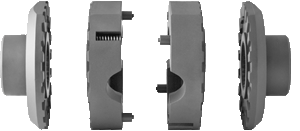
How it Works
Simple explanation
Think of LOKKA as an alternative set of planetary gears.
When factory gears operate or move, so will the LOKKA gears. The difference is, the LOKKA gears start from a locked position, whereas normal gears are free spinning.
The LOKKA mechanism allows a wheel to turn faster than the speed the differential is driving it - (differential action), but never allows a wheel to turn slower than the rotational speed the differential and engine is turning it - (traction). Thus a wheel cannot ever stop turning if the engine is driving it, but in a corner it can be forced to actually turn faster. Unlike a normal differential the engine can never drive one wheel faster than the other.
Detailed Explanation
LOKKA uses a simple method to lock the axles for maximum traction and to unlock them for full differential action, that is as required when cornering or driving on hard surfaces.

The actual principal of operation while easily demonstrated is difficult to explain in writing - but is as follows.
- LOKKA has only 4 main parts - a pair of Cam and Axle (side) gears for each axle, some springs and pins, and some have spacers and shafts.
- LOKKA is normally in a fully locked state and only allows differential action by unlocking the unit when the ground driven force acting on a wheel (either during turning or when negotiating obstacles) forces that wheel to turn faster than the other driven wheel, ie a turning vehicle's wheels actually travel two different paths with the inside wheel turning in one circle while the outside wheel travels in a larger circle, and therefore faster.
- LOKKA makes use of two distinctly different sets of opposing forces that exist due to its design - one to dynamically engage the gears when engine torque is applied and the other to dis-engage the gears when one wheel overruns.
- The locking force is applied by the action of the pinion cross shaft acting on a 4 dimensional spiral cut cam groove with bearing surfaces - the more power applied the harder it locks.
- The unlocking action occurs due to the ramping effect between the low profile, almost zero backlash, ramped teeth which force the cam away from the axle gear (against the minor pressure of the bias springs), for example when an outside wheel turns faster than an inside wheel - when cornering. Power continues to be applied to the inside axle. As the turn is completed and the wheels again rotate at the same speed, the outside lock re-engages.
Note: The bias springs can easily be compressed with 2 fingers, resulting in LOKKA being able to unlock correctly even on low traction surfaces. - It should be understood that only when there is an external force being applied to a wheel to make it turn faster than the rest of the drive train will LOKKA allow one wheel to differentiate. Slippery surfaces where one wheel would normally break traction in an open differential cause LOKKA to stay locked - even with one or both wheels in the air, LOKKA will remain locked.



